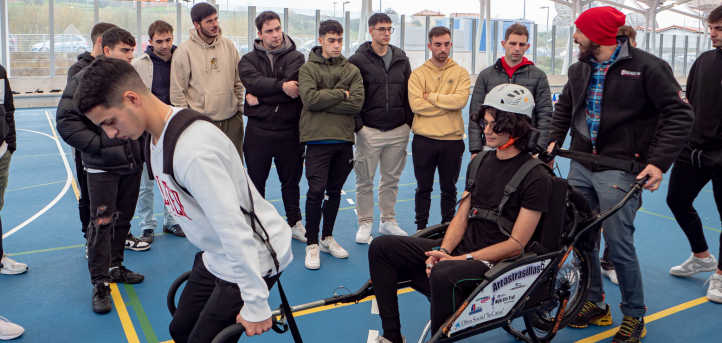Once more, the fourth-year students of the Physical Activity and Sports Sciences Degree at UNEATLANTICO have completed a practice of adapted hiking with Jöelette chairs provided by the Asociación Arrastrasillas, in addition to a circuit with infrastructure and specific techniques to guide people with visual functional diversity through the natural environment. The practice has been carried out on the university campus, from the sports wing to the different outdoor locations of the campus and has had representatives of the organization explain the work they do and offer real testimonies of the benefits of these experiences for people with functional diversity and reduced mobility.
On the one hand, Professor Juan Aparicio showed how joëlette chairs work. Aparicio compared this activity to a “carriage” in which the rider is the most important person of all, as they are the one with the functional disability and, therefore, the cornerstone on which everything else revolves.
At the front, attached to the front of the chair by a harness, are the handles. The terrain determines the number of handles; the more uneven and steeper the slope, the more shooters are needed. A shooter sets the direction and force; they must always do it with the back, not with the arms, because these soon become numb. It should be noted that the person closest to the rider must ensure that their heels never touch the rider, keeping a safe distance so as never to trip over the rider. The rider sits on the saddle. A series of strict precautionary measures are taken for them prior to the start of the trek to ensure maximum safety for every part of their head and body.
Finally, behind the rider is the guide, who oversees stability before, during, and after the process. They must check that the pin is sealed so that the wheel holding the rider is fixed and stable, and to do this, a test is performed by dry pulling the saddle forward to verify that the pin is securely closed. This person must always have their hands on the brakes to minimize risks and thus anticipate any danger or obstacle that may be encountered along the way. If having to climb slopes or stairs is needed, they will need more traction and therefore more handles, but they must always be able to synchronize the steps. The safety of the rider is paramount.
On the other hand, Professor Florent Osmani accompanied the students in the process of putting themselves in the shoes of the blind for a day in an activity of adapted hiking with guided bars formed with pikes where, except for a few, the participants could not use their sense of sight.
Unlike in saddles, in this sport, the guide goes in front since they are the only ones who have a full view. Also, everyone should be on the same side of the bar to facilitate the synchronization of the steps and for safety reasons since the bar is always on the danger side in case there is a possibility of falling off a cliff. Behind all this, there is a partially sighted person, as it is important that there is some vision from that perspective as well. Professor Osmani made special emphasis on the fact that “it is necessary to give constant indications and that there must be a lot of communication between all of them” because “even a small step changes everything“.
With all this, the CAFYD teachers intended that the students learn the techniques and infrastructure necessary for the realization of sports activities in the natural environment with groups with functional diversity. As well as evaluating and interpreting the specific needs of people and groups with functional diversity in the practice of sports in the natural environment. Also, among its objectives was to promote sustainable projects related to physical activity that favor groups with functional diversity. Finally, the aim was to seek transversality with the contents of the subject Inclusion and Diversity.


